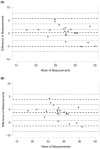Skeletal muscle mass estimation in Brazilian Jiu-Jitsu athletes: validation of predictive equations
- PMID: 40756559
- PMCID: PMC12313502
- DOI: 10.3389/fnut.2025.1595259
Skeletal muscle mass estimation in Brazilian Jiu-Jitsu athletes: validation of predictive equations
Abstract
Accurate estimation of skeletal muscle mass (SMM) is important for body composition assessment in Brazilian Jiu-Jitsu (BJJ) athletes owing to body mass classification and force production implications. This study compared the validity, reliability, and agreement of three predictive equations-Kim, McCarthy, and Sagayama-for estimating total SMM (expressed in kilograms) in male BJJ athletes. Twenty-two male BJJ athletes (mean age: 33.1 ± 7.5 years; body mass: 78.4 ± 9.6 kg; height: 171.8 ± 6.4 cm) underwent DXA-derived body composition analysis. SMM was estimated using the Kim, McCarthy, and Sagayama equations. Statistical analyses included repeated-measures ANOVA, stepwise linear regression, Pearson's correlation, intraclass correlation coefficient (ICC), coefficient of variation (CV%), and Bland-Altman plots. The mean SMM estimated by the Kim equation was 28.95 ± 4.92 kg (95% CI: 26.89-31.00 kg), by the McCarthy equation, 27.39 ± 4.96 kg (95% CI: 25.32-29.47 kg), and by the Sagayama equation, 27.72 ± 3.71 kg (95% CI: 26.16-29.27 kg). The Kim equation yielded significantly higher SMM values than McCarthy (mean difference = 1.55 kg, p < 0.0001), while Sagayama and McCarthy did not differ significantly. Stepwise regression identified the Kim equation as a strong predictor of Sagayama SMM values (R = 0.851; R 2 = 0.724; RMSE = 2.0 kg; F 1, 20 = 52.369; p < 0.001), although with proportional underestimation (slope = 0.642). Reliability was acceptable for all equations (ICC > 0.79), and the Sagayama equation demonstrated the lowest CV% (13.4%, 95% CI: 9.44%-17.36%). Bland-Altman analysis revealed systematic biases, particularly for the Kim equation. All three equations provided accurate validity and reliability for estimating absolute SMM (kg) in BJJ athletes. However, the McCarthy and Sagayama equations showed less bias and greater agreement by DXA, supporting their use for accurate quantification of SMM in this population. Their validation with magnetic resonance imaging is needed.
Keywords: Brazilian Jiu-Jitsu; body composition assessment; dual-energy X-ray absorptiometry; predictive equations; skeletal muscle mass.
Copyright © 2025 Ojeda-Aravena, Báez-San Marín, Dopico-Calvo, Cresp-Barría, Olivares-Arancibia and Azócar-Gallardo.
Conflict of interest statement
The authors declare that the research was conducted in the absence of any commercial or financial relationships that could be construed as a potential conflict of interest.
Figures
Similar articles
-
Comparison of bioelectrical impedance analysis and computed tomography for the assessment of muscle mass in patients with gastric cancer.Nutrition. 2024 May;121:112363. doi: 10.1016/j.nut.2024.112363. Epub 2024 Jan 22. Nutrition. 2024. PMID: 38359703
-
Validity and reliability of anthropometric equations versus Dual X-ray Absorptiometry to estimate body composition in athletes with unilateral lower-limb amputation: A pilot study.PLoS One. 2025 Jul 11;20(7):e0326524. doi: 10.1371/journal.pone.0326524. eCollection 2025. PLoS One. 2025. PMID: 40644425 Free PMC article.
-
Development and validation of a phase-sensitive bioelectrical equation for estimating skeletal muscle mass using DXA as reference.Nutr Metab Cardiovasc Dis. 2025 Aug 20:104281. doi: 10.1016/j.numecd.2025.104281. Online ahead of print. Nutr Metab Cardiovasc Dis. 2025. PMID: 40903338
-
Accuracy of Resting Metabolic Rate Prediction Equations in Athletes: A Systematic Review with Meta-analysis.Sports Med. 2023 Dec;53(12):2373-2398. doi: 10.1007/s40279-023-01896-z. Epub 2023 Aug 26. Sports Med. 2023. PMID: 37632665 Free PMC article.
-
Corticosteroids for the treatment of Duchenne muscular dystrophy.Cochrane Database Syst Rev. 2016 May 5;2016(5):CD003725. doi: 10.1002/14651858.CD003725.pub4. Cochrane Database Syst Rev. 2016. PMID: 27149418 Free PMC article.
References
LinkOut - more resources
Full Text Sources



